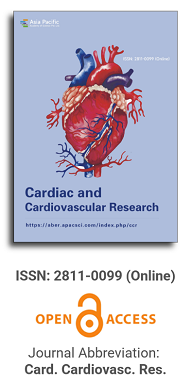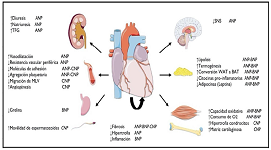
Asia Pacific Academy of Science Pte. Ltd. (APACSCI) specializes in international journal publishing. APACSCI adopts the open access publishing model and provides an important communication bridge for academic groups whose interest fields include engineering, technology, medicine, computer, mathematics, agriculture and forestry, and environment.

The theme of this issue is the risk assessment of cardiovascular diseases, analyzing the susceptibility to cardiovascular disease among different populations and regions to provide important evidence for formulating effective prevention strategies and improving patient outcomes.
Issue release: 30 June 2021
Because it contains pathological characteristics such as changes in myocardial tissue characteristics, the deformation and dynamic characteristics of human left ventricle have become an important basis for clinical diagnosis of heart disease. Based on BP neural network method, this study carries out the identification of left ventricular myocardial tissue parameters through the inversion of left ventricular clinical diagnosis data. Firstly, the image recognition program is written in MATLAB language to extract the location points of inner and outer membranes in human left ventricular CT image, establish the real geometric model of left ventricle in solidworks software, and establish the finite element analysis model of left ventricle through ABAQUS software. Secondly, Mooney Rivlin hyperelastic model is used to simulate the characteristics of myocardial tissue, ABAQUS finite element software is used to conduct dynamic numerical analysis on the left ventricular finite element model, and 45 groups of input target vectors of BP neural network corresponding to three characteristic moments are obtained. Finally, the BP neural network program is written in MATLAB language to train the input target vector, and establish the nonlinear mapping relationship between left ventricular diagnostic data and myocardial tissue parameters. The analysis results of examples show that BP neural network can be well used for myocardial tissue parameter inversion based on clinical data, and is expected to become an effective method for clinical diagnosis of left ventricular lesions caused by changes in myocardial tissue characteristics.
Issue release: 30 June 2021
With the development of society and economy, the number of cardiovascular diseases continues to increase. Accurate prediction of cardiovascular mortality can guide the prevention of cardiovascular events and the sustainable development of public health. This paper mainly studies the grey Markov prediction model of cardiovascular disease mortality, proposes an improved grey Markov prediction model, and then uses the statistical data of cardiovascular disease mortality in rural and urban areas from 1991 to 2018 for numerical simulation. The simulation results show that the improved grey Markov prediction model is effective.
Issue release: 30 June 2021
This study proposes a new automatic classification method of arrhythmias to assist doctors in diagnosing and treating arrhythmias. The convolution neural network is constructed to extract the features of ECG signals and wavelet components of QRS complex. The ECG signal features and wavelet features extracted by the network and the artificially extracted RR interval features are input to the full connection layer for fusion, and the softmax function is used to classify the beats in the output layer. The network is trained and tested using the mil lead data in MIT BIH arrhythmia database. The overall classification accuracy of this method is 98.12%, the average sensitivity is 87.32%, and the average positive predictive value is 90.37%. This method can quickly identify different types of arrhythmias, and has certain reference value for the application of computer-aided diagnosis of arrhythmias.
Issue release: 30 June 2021
Objective: Based on the global burden of disease (GBD) 2019 study, to analyze the epidemic trend and risk factors of cardiovascular disease (CVD) in China by comparing the world, the United States, Japan and India. Methods data were obtained from the global health data exchange (ghdx) database. The prevalence, morbidity, mortality, disability adjusted life year (DALY) and other disease burden status and main risk factors of CVD in China were analyzed by sex and age; the age standardized rate was used to compare the change trend of CVD disease burden in China, the United States, Japan and India from 1990 to 2019. Results: In 2019, the number of CVD patients in China was 12 billion, with 123.41 million new cases and 458.43 million deaths; the prevalence, incidence rate, mortality and Daly rates increased from 423,543/100,000, 44,781/100,000, 20,475/100,000 and 509,103/100,000 in 1990 to 84,608/100,000, 86,765/100,000, 32,230/100,000 and 646,347/100,000 in 2019 respectively. The prevalence, incidence rate, mortality and Daly rate increased with age, and the burden of CVD in men was higher than that in women. In addition, the top 4 risk factors for CVD in China in 2019 are hypertension, diet, air pollution and tobacco, which lead to higher CVD disease burden than the global average. Conclusion: due to hypertension, dietary factors, air pollution, tobacco and other reasons, coupled with the rapid aging of the population, the disease burden of CVD in China is still very serious, which needs to be paid attention to by relevant departments.
Issue release: 30 June 2021
Introduction: Cardiovascular diseases are among the leading causes of death worldwide and the scientific evidence suggests that they have an origin at early ages, so reducing from adolescence the risks that contribute to their appearance is indispensable. Objective: To determine cardiovascular risk in the adolescent population of an educational institution in Timbío, Cauca, 2015 - 2016. Methodology: Quantitative, descriptive, observational and cross-sectional study. Sample: 100 students (47 females, 53 males), aged 10 to 19 years. Sociodemographic, anthropometric, biological, biochemical (glycemia), personal and family history, lifestyles and oral contraceptive use variables were evaluated. Results: A higher prevalence of cardiovascular risk was found in the adolescent age group (15-18 years) with 84.6%; the female gender presented a greater possibility of having cardiovascular risk (OR: 2.8, 95% CI 1.17 - 6.87); 7% reported regular tobacco use and 12% were passive smokers. The presence of unhealthy eating habits generated a higher cardiovascular risk (OR: 5.57, 95% CI 1.95-15.90). 67% (n= 67) have cardiovascular risk. Conclusions: Female gender, adolescent group (15-18 years), consumption of alcoholic beverages and unhealthy eating habits are associated with a higher possibility of having cardiovascular risk. Cardiovascular risk was found in a large percentage of the study population.
Issue release: 30 June 2021
Background: Of the 607 fatal occupational accidents that occurred in Spain in 2016, 37.9% were due to ischemic heart disease and stroke. Working conditions such as night work, noise or respiratory contaminants were associated with a higher cardiovascular incidence. The aim of the present study was to assess whether health surveillance in workers exposed to these conditions should include assessment of cardiovascular risk. Subjects and methods: A cross-sectional study was conducted in 680 workers in a public administration. The qualification of working conditions was obtained from the company risk assessment and from personal, anthropometric and analytical data, which allowed the assessment of cardiovascular risk in the medical examination performed in 2015. Results: 30.1% of the sample were exposed to these working conditions, with significant differences by sex (37% in men, 11.9% in women, p<0.05). According to REGICOR, 13.2% of those exposed were classified as particularly sensitive to cardiovascular risk. Conclusions: A large percentage of workers are exposed to TC related to a greater prevalence of cardiovascular pathology. The percentage of workers classified as especially sensitive to cardiovascular risk among those exposed suggests that this risk should be assessed in occupational health surveillance when there are working conditions related to cardiovascular pathology.

Prof. Prakash Deedwania
University of California,
San Francisco, United States





 Open Access
Open Access